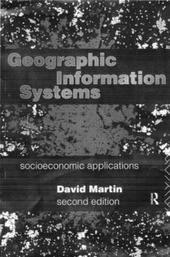
|
Geographic Information Systems: Socioeconomic Applications
Paperback
Main Details
| Title |
Geographic Information Systems: Socioeconomic Applications
|
| Authors and Contributors |
By (author) David Martin
|
| Physical Properties |
| Format:Paperback | | Pages:240 | | Dimensions(mm): Height 234,Width 156 |
|
| Category/Genre | Computer science |
|---|
| ISBN/Barcode |
9780415125727
|
| Classifications | Dewey:910.285 |
|---|
| Audience | | Undergraduate | | Postgraduate, Research & Scholarly | | Professional & Vocational | |
|---|
| Edition |
2nd Revised edition
|
| Illustrations |
5 black & white tables
|
|
Publishing Details |
| Publisher |
Taylor & Francis Ltd
|
| Imprint |
Routledge
|
| Publication Date |
14 December 1995 |
| Publication Country |
United Kingdom
|
Description
Geographic Information Systems (GIS) are now essential to the work of an incrasingly diverse range of organizations concerned with population characteristics, from local government and health authorities to major retailers and marketing agencies. David Martin presents an accessible introduction to the history, principles and techniques of GIS, with a unique focus on socioeconomic applications. This non-technical overview of the collection, input, storage, manipulation and output of data addresses the needs of students and professionals who must understand and use GIS for the first time. This second edition builds on the strengths of the first. Taking into account recent advances in GIS development and major new socioeconomic datasets (including new census data), it explores more fully the contribution of GIS to geography and their power in influencing our environment.
Reviews"Already a useful, readable and informative introduction to both GIS and socioeconomic applications, this new edition brings the subject matter nicely up to date in what is currently a rapidly developing area of GIS."-David Green, University of Aberdeen "An insightful, comprehensive and accessible account of GIS theory and practice. David Martin's own research is at the forefront of socioeconomic and demographic applications of GIS and users entering this field can benefit from his insight. His updated text is sure to be widely read and deserves to be high on the list of essential reading for anyone interested in population and all GIS users."-Stephen Matthews, Population Research Institute, Pennsylvania State University
|